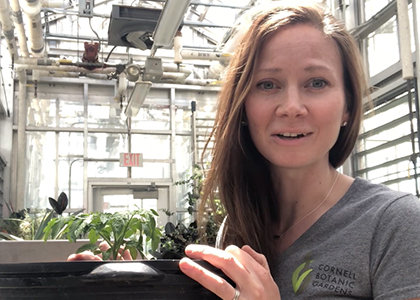
Living in such unusual times has encouraged many folks to discover or rediscover their passion for growing their own food. There is a great sense of security and pride that comes with providing for your family, and a large space isn’t necessary to enjoy the beauty and bounty of a garden. There are many great ways to use your small space and containers so that you have a successful year.
It is said that plans are nothing and planning is everything, so give some thought to the plant, the watering, the soil, the container and the environment.
Cornell Botanic Gardens | Growing Vegetables in Containers from Cornell Botanic Gardens on Vimeo.
There are many crops on the market that are bred specifically for small spaces and containers. but you certainly aren’t limited to these. Carrots, peppers, bunching onions, eggplants, tomatoes, radishes, greens, peas, beans, beets and potatoes can all be grown successfully in containers. For herbs, thyme and rosemary enjoy a dryer soil and can thrive in containers. Mint and chives can be quite aggressive so growing them in pots is a great way to help contain that behavior. Other herbs that fit the bill are basil, parsley, tarragon and cilantro.
It’s very important to keep your plants regularly watered, whether in raised beds or containers. Inconsistent watering can cause blossom end rot in tomatoes, peppers and squash, increasing the chance of pests and disease and drastically lowering your yield. Overwatering and underwatering can look similar, so pay attention to your soil as much as the plant! When choosing a growing medium, it’s common to use a blend of potting soil and compost, but use no more than 30 percent compost.
When picking a container, consider how big each plant gets and how much root space it will need to thrive. Lettuce greens won’t need the same space or pot depth as a tomato. Be sure your container can fully drain and that you don’t over crowd the plants, which can reduce yield and increase the risk of pests and disease. Vertical gardening and succession planting are fantastic ways to take advantage of the space and take in a higher yield.
And lastly, be sure your efforts are in the right place—is your small space going to get enough light for the plants you are growing? Too sunny? Is this spot very windy? Many containers can be easily moved to more ideal locations at any time.
As with life, we can enjoy successful gardening with some planning, high hopes and realistic expectations. Remember to embrace the failures, they only help us to become better gardeners!
Stay safe and happy planting!